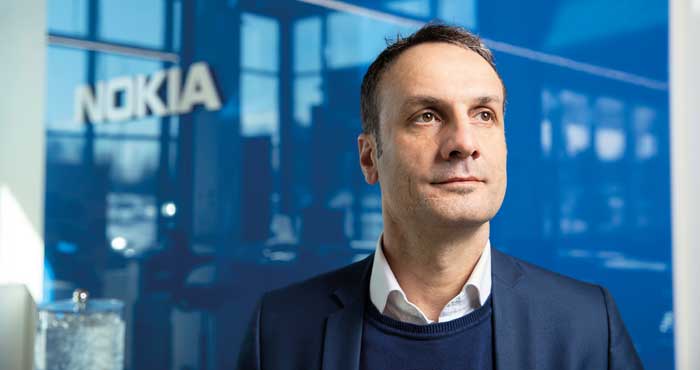Nokia creates technology that connects the world. Now they are looking to 5G networks and new opportunities with the cloud.
Since leaving phone manufacturing behind, Nokia has concentrated on dominating the world as a supplier of network hardware, software and services. Its customer base consists of telecom operators and communications service providers preparing for the introduction of 5G networks and, to a large extent, big companies.
”Faster and more effective connections are revolutionizing how people live, work and communicate,” says Yilmaz Karayilan, Head of Nokia’s Engineering and Services Cloud (NESC) Services.
“For example the use of sensors is increasing everywhere. To take advantage these, we have to build new network solutions that enable the intelligence to be taken to where the data is generated.”
In addition to networks, Nokia also has invested heavily in cloud technology—first for its own use, and now as a new business.
NESC private cloud is among the largest in the world
NESC is a private cloud solution that Nokia has developed for years and can be used by telecom operators and companies as an on-premises infrastructure as service (IaaS) platform.
“We have been building this solution for eight years, and it has been heavily used internally. As we continuously break boundaries in the cloud, NESC’s architecture also evolves. The time is right for us to offer NESC to our customers,” Karayilan explains.
According to Karayilan, the high-use NESC does not compete in the cloud market with giants like Azure and AWS because it is an on-premises private cloud. The scale of NESC makes it one of the world’s largest corporate private clouds built on OpenStack.
Local service clouds like NESC offer customers the benefits of simpler legal compliance (such as for data privacy), guaranteed resource availability and advanced security. Moving the data of millions of end users to a public cloud under another country’s laws and rules would require significant legal effort. In addition, many companies still question the maturity level of public clouds.
“Everyone wants to go to the cloud because the services are not dependent on a company’s size or industry. But, moving to the cloud requires a sound business case and making sure you are operating securely in the cloud,” Karayilan emphasizes.
Cloud strategy requires realism
Although the cloud is not new, Karayilan says its optimal use is far from being achieved.
“Initially, on-premises applications would run in the cloud day and night. With public cloud, you pay accordingly. Most companies lack the ability to develop cloud-native applications that scale to actual usage,”explains Karayilan.
Additionally, companies with decades-old legacy systems have been running these systems in parallel. Moving them fast to the public cloud can be expensive if you do not know what you are doing. The situation is completely different for firms like Netflix and Supercell who were born in the cloud era and run only one service.
As a positive development, Karayilan highlights the hybrid cloud services that emerged a couple of years ago. They enable companies to assemble different environments and systems into a manageable set of services, which Nokia also uses. It is essential to ensure that the chosen service meets company needs and is implemented in a controlled manner.
“Legacy companies struggle between the cloud and being local. Companies are reluctant to invest in taking older systems to the cloud. Therefore, a company needs a realistic cloud strategy. What’s important is not the cloud itself, but having everything work a planned,” summarizes Karayilan.
CGI cloud services and Nokia
Preceding the launch of the NESC service was a cloud transformation project assisted by CGI’s cloud acceleration services.
”There were many variables in the cloud transformation project, including several data centers on many continents, the cloud technologies used, and a tight schedule,” says Timo Pellikka, responsible for cloud acceleration services at CGI in Finland. “Effective collaboration and communication on both sides of the table were keys to success. Also important was our experts’ understanding of both cloud technologies and the requirements of the different business applications.”
CGI’s cloud acceleration services bring the best technologies and operating models to clients from an experienced team of experts. This ensures both a controlled transformation as well as optimal maintenance and further development. Learn more about CGI’s cloud solutions and services.
"At Nokia’s scale and level of demand, everything needs to run without surprises. With CGI, this project was completed in record time without unforeseen interruptions. We succeeded in making a big technological change in a well-controlled manner. Best of all, the cloud transformation paved the way for new business,” adds Karayilan.
Adapted from original article in Ratkaisu magazine published by CGI in Finland





